March 1st, 2014 §
Last night I drank half a glass of wine and candled the 15 eggs I’d put under a newly broody hen Sunday. What, this isn’t your idea of a rocking Friday night?
Maybe not for most people, but for me candling eggs induces Christmas-morning excitement. There are few things cooler in this world than getting to peek into an intact egg, with nothing more than a flashlight, and see bright red veins, a beating blob of heart and small dark eye. It is a magic trick, a miracle, and all those other things that make me grateful to be along for this wild ride.
Out of fifteen eggs, eight were definitely on the road to becoming chicks. One egg was a big fat question mark, and I magnanimously returned it to the clutch. I suspected five eggs were infertile, and in the interest of self education I risked destroying embryos to crack the eggs into a white bowl to check. All five were totally clear. My instinct and eye must be getting sharper.
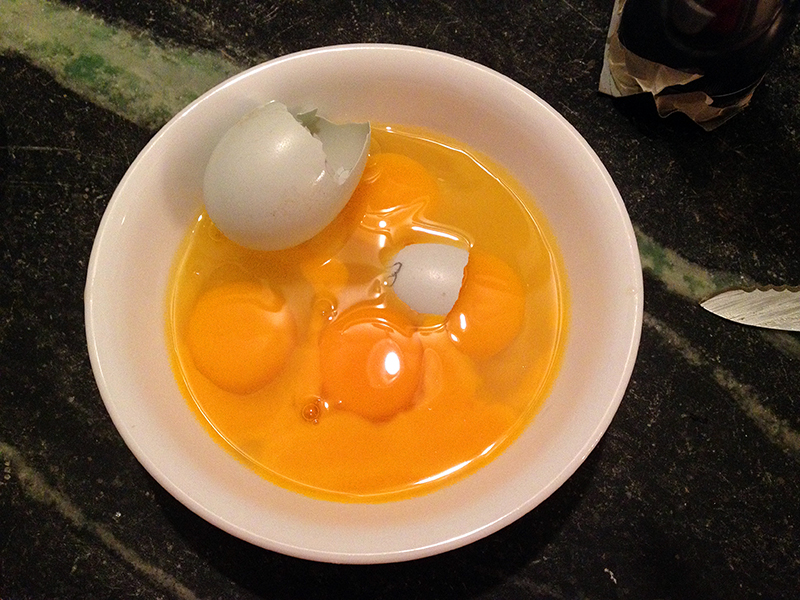
I didn’t take any photos of the developing eggs this time because I wanted them to be out in the cold air as little as possible. In fact, I withdrew them from under their mother two at a time, quickly candled them, and then snuggled them into a pan full of clean towels to hold their heat as much as possible. The whole operation was over in minutes. My pipes may have fallen victim to the polar vortex, but my potential chicks shouldn’t. If you want to see candling photos, they’re here.
I have high hopes for this hen as a broody. She’s one of last summer’s olive egger babies, and there’s a 50% chance she is Dahlia’s daughter. I only mention that because broodiness is a genetic trait. The young broody started plucking her breast feathers out a few weeks ago, and then hunkered down on all her flockmates’ eggs, hissing violently at any chicken that got too close. She’s the only broody out of the four I’ve had that’s actually pecked at me when I reached under her, and I take this feistiness as a good sign. I suppose I should name her as she’s definitely distinguishing herself.
I was on the fence about whether to do chicks again, but finally decided that it’s the best part of chicken keeping and costs me nothing. So I moved the broody to a coop in the garage, where she settled immediately despite being moved during the day, having a raucous rooster (Griz) in the coop next door, and me driving the loud and stinky tractor in and out right after the move. She remained steadfast, I set the eggs, and here we are.
I placed four eggs from my Coronation Sussex, two from last year’s olive egger babies, and nine Wheaten Ameraucana eggs from Cora under the hen. I removed all four of the Coronation eggs tonight, which were all infertile, and one Wheaten Ameraucana egg that was one of the oldest I placed, and had also cycled through the refrigerator as I waffled. I find it telling that my Coronation Sussex hen is the only bird that still has luxuriant feathers on her back and all her eggs were infertile. The hens that laid the fertile eggs are all looking a bit sparse back there because of Calabrese’s attentions. Another lesson learned—keep an eye out for “favorite” hens when scouting future mothers.
I just read back through last summer’s pained posts on hatching eggs, and I have to say that after that experience and this, I will never again let a hen set eggs in the middle of the summer. I realize now that the heat was really detrimental, leading to spoiled eggs that burst and contaminated the nest, and to chicks that were born prematurely and deformed. Incubating in the winter is the way to go. Live and learn.
But then again, we’re only five days into the 21-day incubation period, so let’s not count our chicks before they hatch, right?
August 5th, 2013 §
Are gross.
On Saturday I was doing some cleanup in the garden and went to clip this dead branch out of the giant rosemary in the front garden.

As I was reaching toward the bush my spidey sense twinged, and in that instant I caught sight of a quarter inch of shiny black skin wound up around the plant.
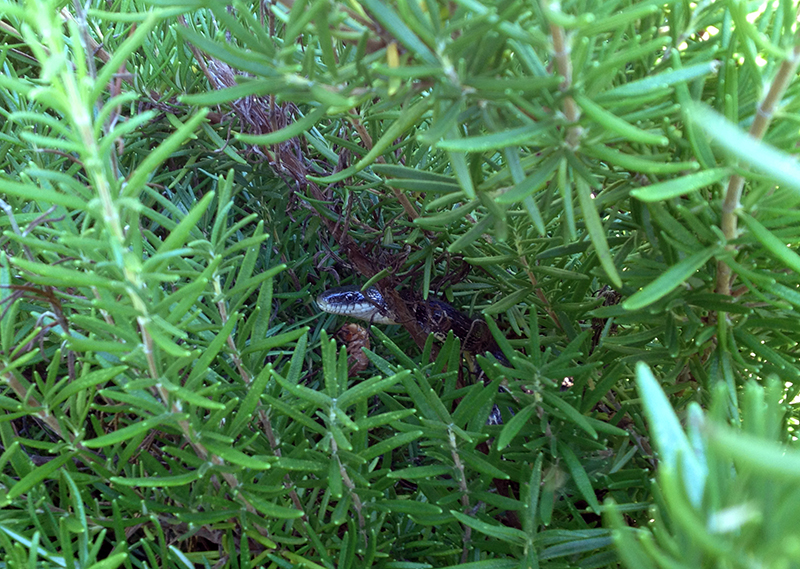
And this guy came out to say hi. He (or she) is just a little black snake, probably one of the 16 born under the front sidewalk, yech. I know they’re good to have around, but I don’t want to reach into a plant and grab a snake instead of a stem. Needless to say I gave the rosemary a wide berth as I finished cleaning up the garden.
Then later that night I called Tuck in from his before-bed rounds. I had his topical tick medication all lined up to apply, and as I squirted it on the back of his neck I noticed he had what looked like cinnamon powder all over his head around his eyes. I brushed at it and instantly dozens of teeny tiny ticks started marching up my arm. Oh, the irony! There are few things I find grosser than seed ticks, so I ran for the office to grab my packing tape.
I deticked myself with the sticky side of the tape, and then set about pressing strips of tape to my poor dog’s eyeballs, trying to get the ticks out of his fur. He was a patient champ, but it was not a brilliant way to wind down before bed as I found my skin crawling all night with (hopefully) psychosomatic bloodsuckers.
It was one of those nights (which happen pretty often here, actually) when I felt like I’d had quite enough of country living, thank you very much.
June 28th, 2013 §
Today marks the halfway point in the incubation of the chicken eggs. It’s been ten days since I placed them under the hens, and my most respected chicken resource states that eggs incubated under broodies usually hatch in twenty days instead of the 21 days for mechanically incubated eggs. We shall see. As it is things aren’t looking awesome in the brood coops, and my confidence in the viability of these hatches is waning.
One of the eggs in Oregano’s coop was broken when I checked earlier in the week, and then yesterday I found the broken shell of a Coronation Sussex egg—the prettiest one of the bunch. Boo.
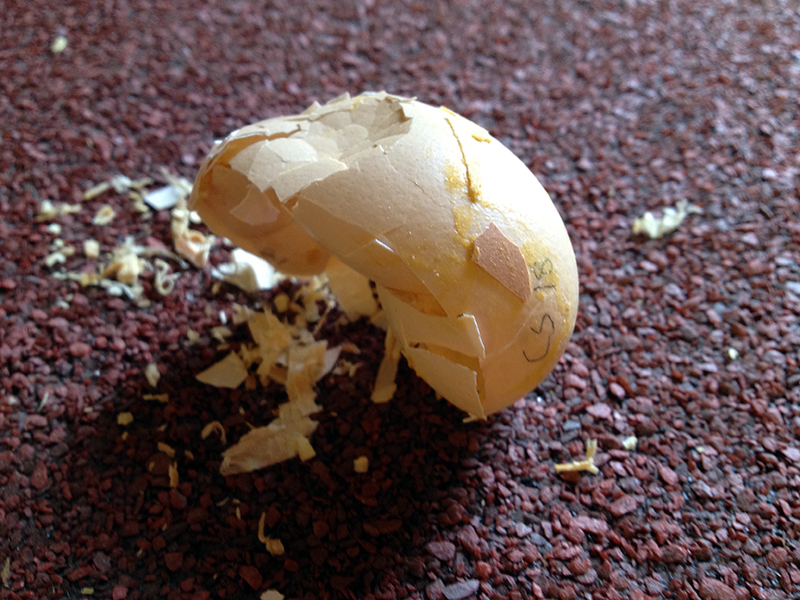
I don’t know if they are breaking on their own because they are rotten or if she’s cracking (and possibly eating) them. That nest box didn’t smell horribly of rotten egg, so I suspect the egg was fertile when broken. However, I don’t know how many days it would take under the hen for an infertile egg to spoil. So that’s the situation in Oregano’s coop. She’s been getting off the nest, as evidenced by her “deposits” in the cage, and has lost a lot of weight already. Broody hens generally don’t eat much while sitting, and if they do get off the nest their poo has such a strange and horrible smell that it’s enough to gag you just walking into a room with it. Needless to say I remove it as soon as it’s discovered, to keep flies off it and to get it out of my life and into the compost pile.
Over in Dahlia’s coop, I found a major mess in her nest box. One of the olive egger eggs placed under her was broken, and it had made a horrid fermented/cooked mess in the nest. At least five of the ten remaining eggs were coated in dried egg goo. Not good, for several reasons. The incubating egg is a living vessel, and its shell needs to be clean to allow air to pass in to the developing embryo. To seal the pores of the egg could suffocate the embryo.
I was at a loss as to what do. I know the embryos need air, but I also know that to wash an egg is to remove its “bloom” or protective covering that helps keep bacteria out of the egg. In this case, though, I figured washing was probably the lesser of two evil decisions, so I gently scrubbed the dried egg off the dirty eggs.
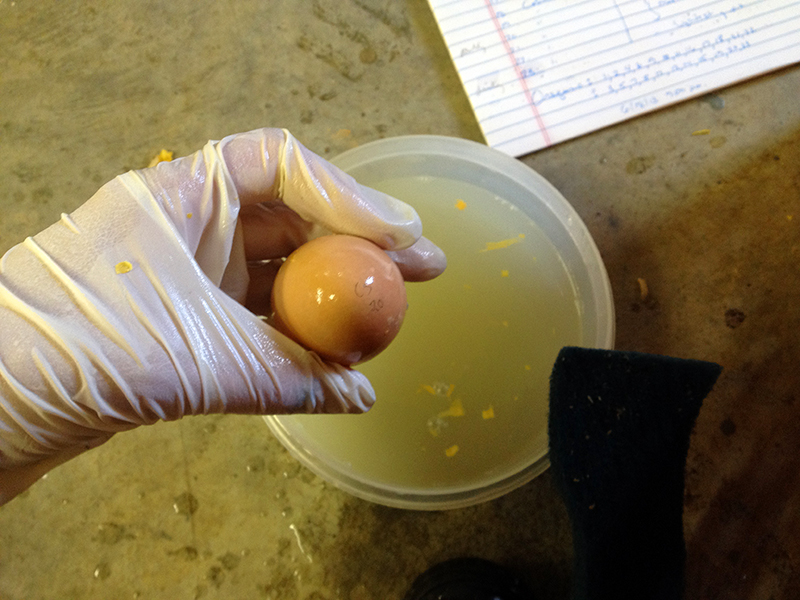
Oregano had a few dirty eggs too, so I touched those up as well, trying to just wash the dirtiest areas. Then I cleaned out Dahlia’s stinking messy nest, filling it with clean pine shavings. I made notes in my log of which eggs I washed, which may be telling around hatch day.
Of course I started this project before suiting up with gloves, and the stink that was on those eggs was so strong I couldn’t get it off my fingers all night despite multiple scrubbings and soaking in lemon juice. In all, it was a fittingly disgusting ending to an evening that began by killing a black widow in the crawlspace. Ugh.
Tonight it was time to candle the eggs, which means I shine a light through them to see if they are developing into chicks. I made a candler out of a MagLight flashlight (with fresh batteries) topped by a taped-on piece of cardboard to concentrate the beam and cushion the eggs.
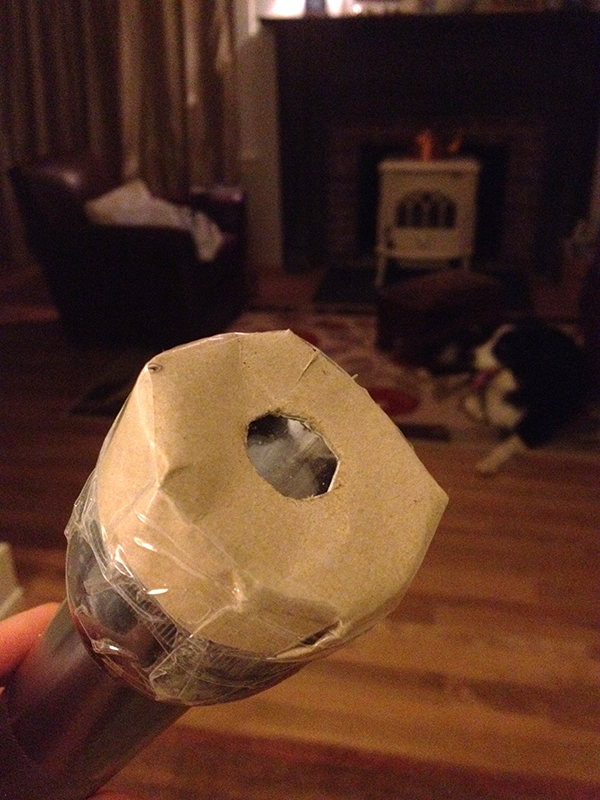
Then after dark I headed out to the garage to candle the eggs. All I needed was my candler, my record log and pencil, and a small dish to hold the eggs as I pulled them from the nest. I waited for the garage door lights to go off and began with Oregano’s eggs.
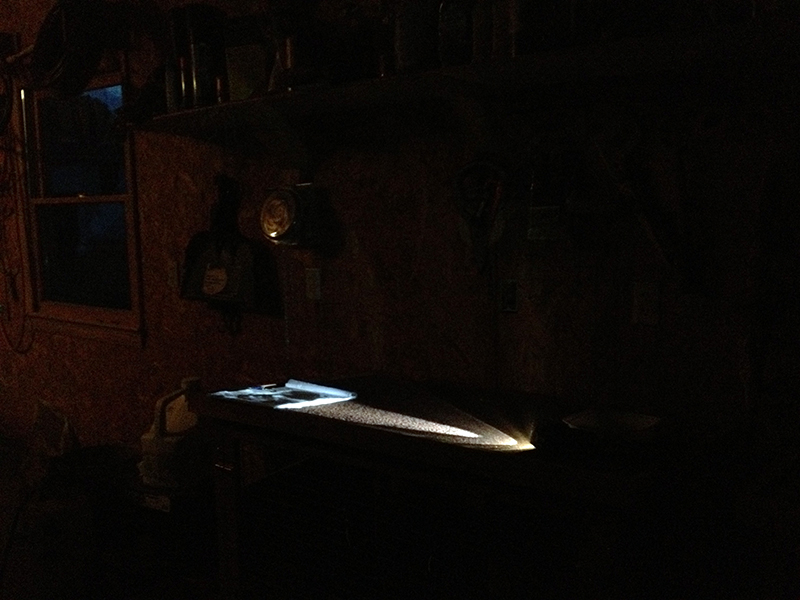
I removed each egg from under Oregano, enduring a peck on the wrist each time, bless her. I held the egg over the end of the candler, turning it until I could see something, or nothing. Most eggs looked like this, below, with some murky shape with no clearly defined blood vessels but perhaps the hint of a developing eye. Perhaps because many of them are Black Copper Marans eggs, which are dark to begin with and thus more difficult to candle.You can clearly see the air sack at the bottom of the egg.
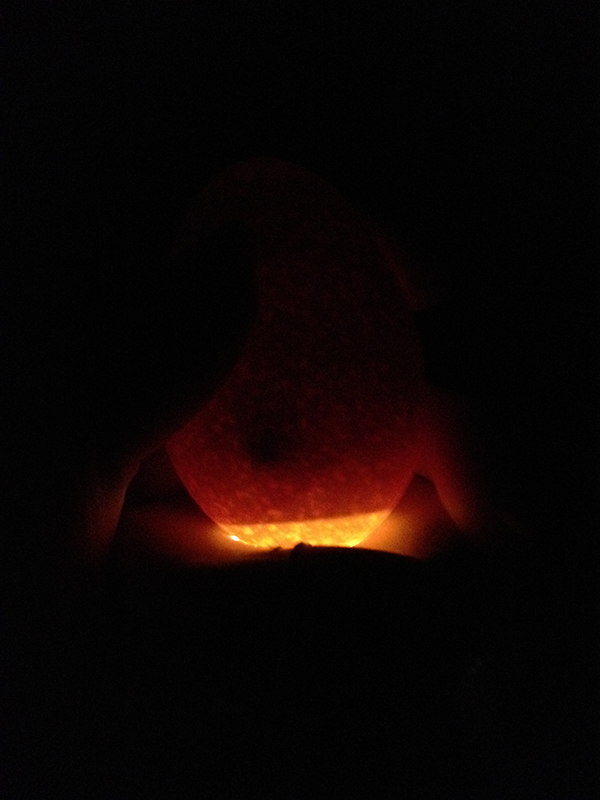
Here’s an egg in which you can see some veins and perhaps a developing eye, right on the line between shadow and light.
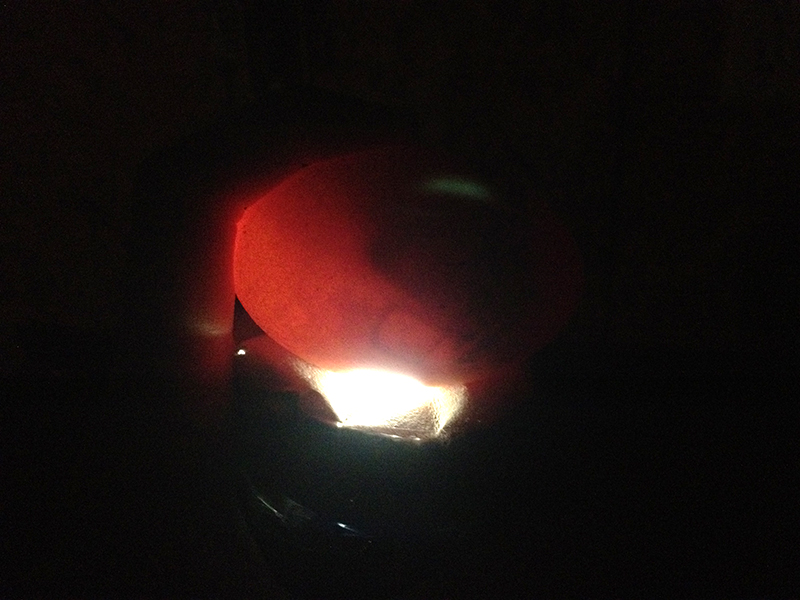
Here’s an egg, unfortunately one of the two remaining olive egger (Oregano’s) eggs, that I think has no development:
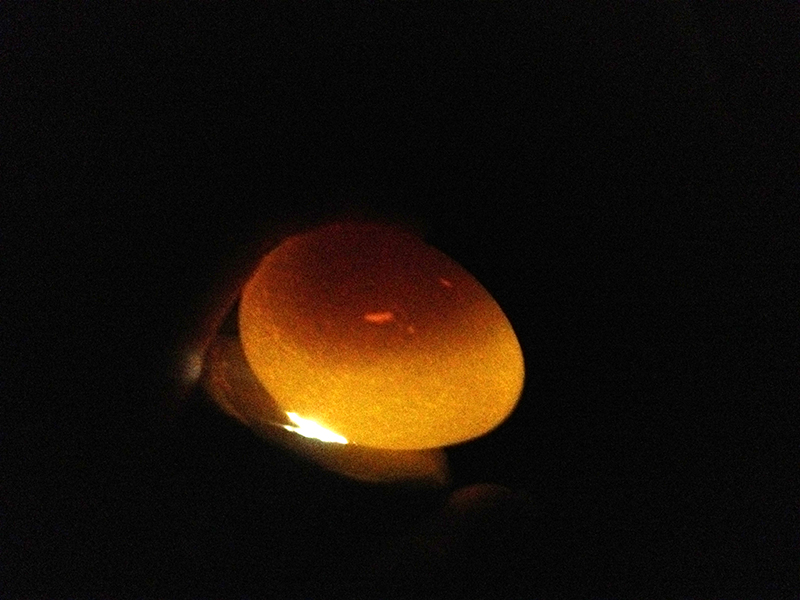
Here’s a Black Copper Marans egg that appeared very porous. This porosity is thought to be an indication of a poor egg for hatching.
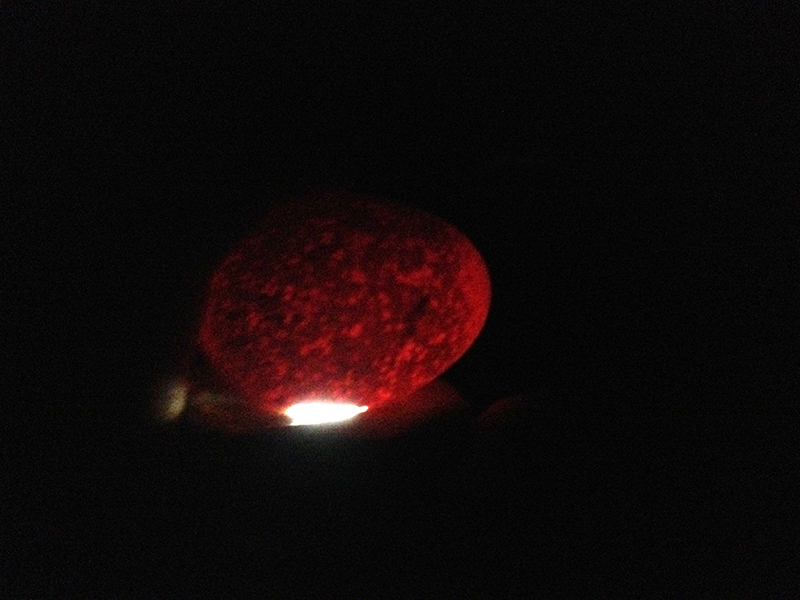
The clearest picture came from the last egg I candled, a Coronation Sussex under Dahlia. You can definitely see a healthy pattern of veins, and as I watched, I could even see the embryo moving within the shell.
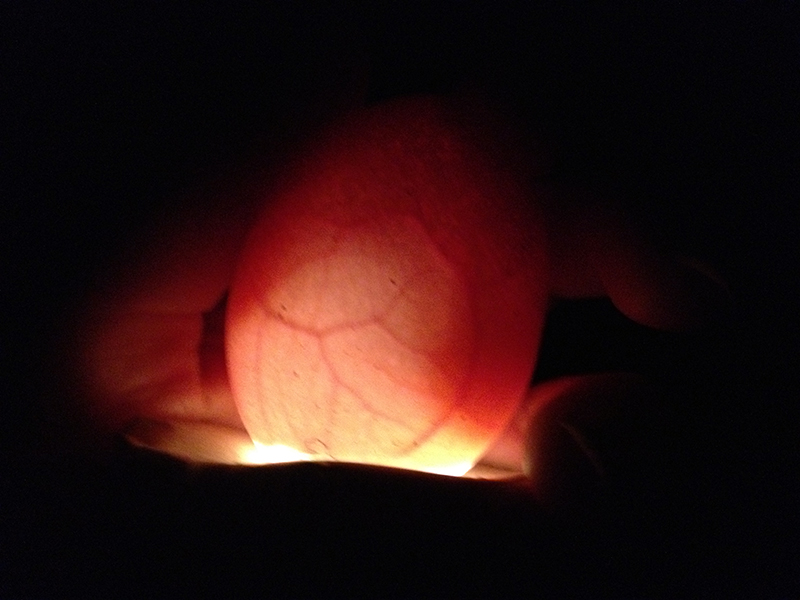
I have to admit that holding this egg in my hand, in the dark, and seeing those veins pulse is a pretty freaking incredible feeling. It’s scary, to hold such perfectly planned beauty alive within that fragile shell.
Out of the 20 remaining eggs, there is only one (the olive egger) that I feel I can conclusively describe as not developing. The rest are big question marks, and I am not yet experienced enough to discard any eggs based on my judgement. I feel better about the clutch under Dahlia, my Black Copper Marans, than the clutch under Oregano, my olive egger. But that’s just a hunch. So they will all stay put in the nest, and we will wait the ten more days to see what becomes of them. As you can already tell, a lot can happen in the next ten days. And so I remind myself, and you, dear reader: “Don’t count your chickens until they hatch.”
June 18th, 2013 §
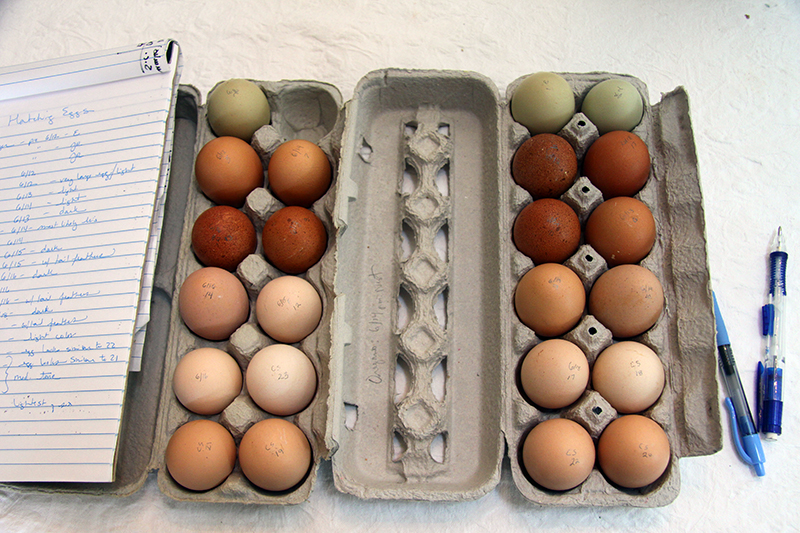
There are just a few intimate acts that are on par with reaching, in the dark, beneath a broody hen’s body, into the damp heat of her defeathered breast, feeling for eggs that pulse with embroynic blood. My years of developing film and photographs in the darkroom served me well as I navigated by feel alone. Oregano gave me a few good pecks on the wrist, bless her defensive spirit, and Dahlia let loose with a series of low perturbed squawks as I mussed about beneath her.
I took Oregano’s sacrifical eggs from her and and placed them in an old cardboard box grabbed off the garage floor, stretching as I did through the sticky web of a mother spider guarding her egg sac.
And then I replaced the stolen neverbabies with twelve fresh eggs for Oregano and eleven for Dahlia, of all colors and shapes, with a prayer for the suspended lives within.
And the 21-day countdown begins toward life or no life. It all comes down to the proper application of heat and humidity. Amazing, every time.
April 9th, 2013 §
While others scrutinize royal pea coats for any sign of swelling, and still others seek all “news” of reality star/rapper spawn, my eyes will be fixed in the backyard, right here:
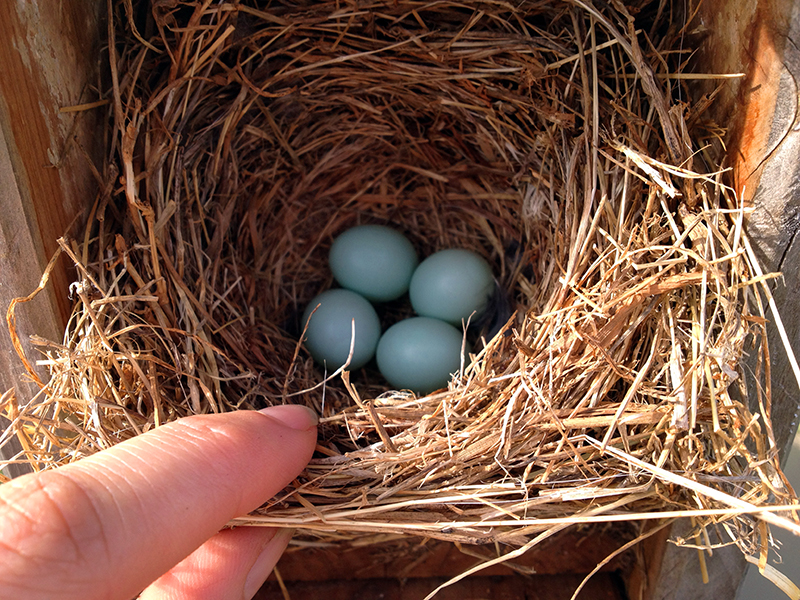
Mr. and Mrs. Bluebird are nesting again. I have high hopes this time around, as this is the first early spring clutch since installing my homemade metal baffle, which should help protect the nest from snakes and other predators.
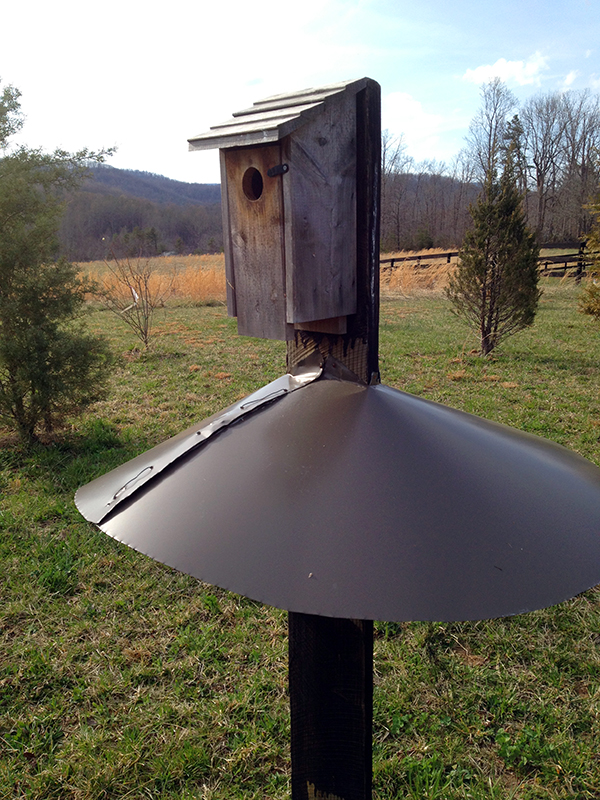
I had mixed success in years’ past, with some eggs disappearing, some chicks mysteriously dying, and then others that made it to—I think—fledging.
I just checked back and it was one year ago to the day that I had discovered last year’s first clutch of eggs. I find this chronological tidbit fascinating.















